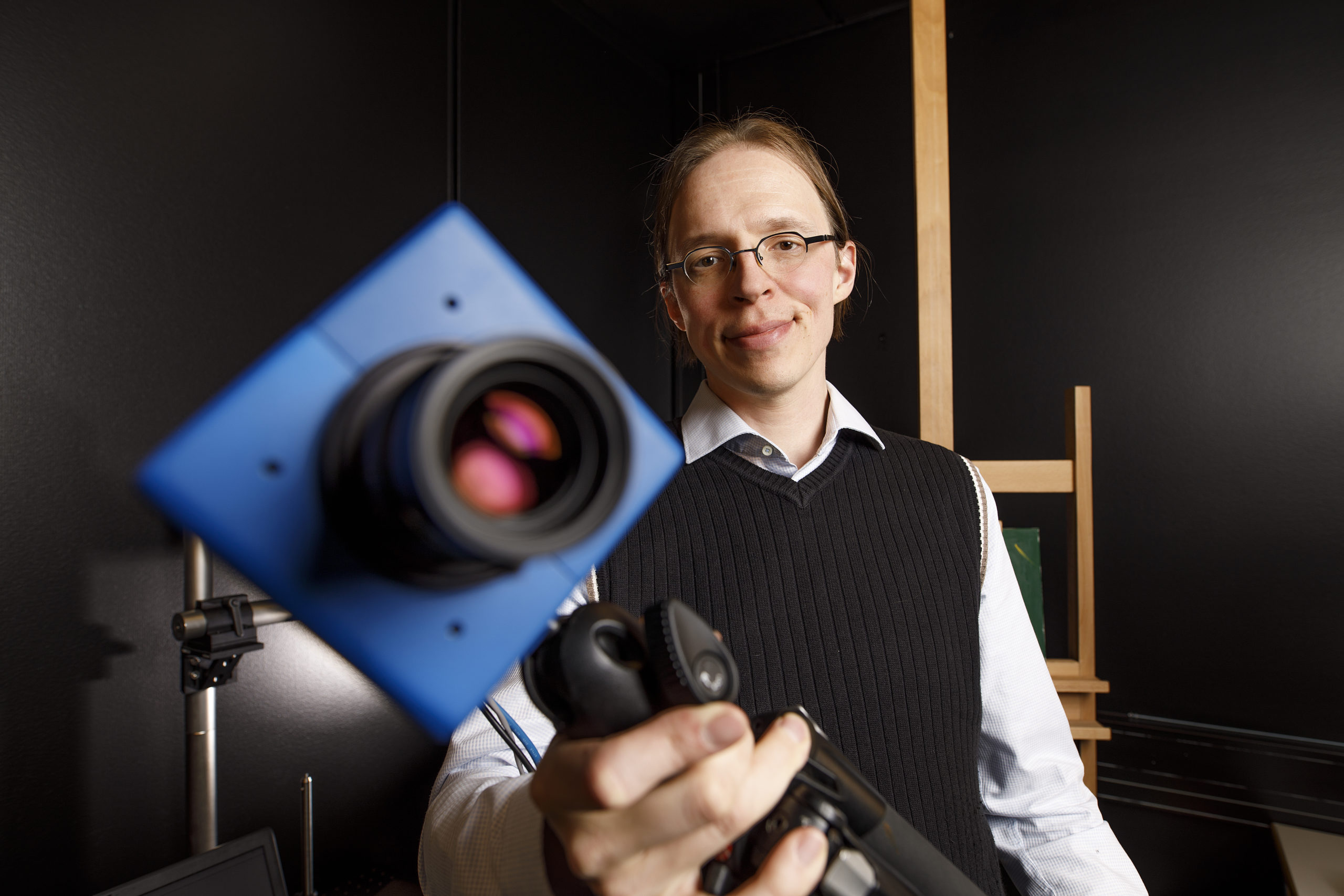Ilkka Pölönen and his research team study computational methods that can be applied to the analysis of hyperspectral images. Hyperspectral imaging can be used, for example, to detect what is under the paint layer of an artistic painting, to determine whether a mole is malignant, or to find out what the crop yield forecast is like for a specific field. There is still plenty of room for innovation in this area.
HYPERSPECTRAL CAMERA is a device that scans an object at a number of different wavelengths of light, from visible to infrared. The final image usually consists of several dozens or hundreds of images produced at different wavelengths, where a single pixel forms a spectrum. The spectrum can be used to identify the properties of the scanned object, such as how much of a particular material is present in the image or what substance the object consists of.
Associate Professor Ilkka Pölönen is an internationally renowned expert in hyperspectral imaging, who leads a number of research projects related to hyperspectral imaging. He defended his doctoral dissertation in 2013 after studying the preprocessing and analysis of data obtained from hyperspectral images in applications such as remote sensing by drones, in medicine, and in forensic investigation. At present, he works as a postdoctoral research fellow at the Faculty of Information Technology of the University of Jyväskylä, where he continues to study computational methods together with three postdoctoral researchers and four doctoral students.
“The hyperspectral camera attracted my interest, because the fact that it measures the spectrum creates opportunities to examine the phenomenon from a variety of perspectives. Light scattering is a physical phenomenon that can be imaged by applying mathematical models. Not to mention the numerous applications in which the phenomenon can be utilised,” Pölönen explains.
Start-ups from Oulu, miniature cameras from Otaniemi
Finland is considered a top country in hyperspectral imaging. In as early as the beginning of the 1990s, a research team from the Technical Research Centre of Finland VTT was set up in Oulu that developed hyperspectral imaging and gave birth to a startup company named Spectral Imaging Oy Ltd, or Specim. The hyperspectral camera business of Rikola Oy, which in 2016 merged as part of Senop, a subsidiary of Millog, was also launched in Oulu.
“A few years ago, I met a Belgian scientist who has been working in remote sensing satellite programmes since the 1980s. He told me that when, in the 1990s, others talked about multispectral cameras that were able to record a few spectra, Finns enthused about hyperspectral cameras that could store a whole lot more information.
In terms of technology, Specim’s cameras are line scanners where the camera moves over the object or the object moves under the camera during scanning. Senop’s implementation is based on a filter that moves inside the camera. At VTT in Otaniemi, small spectral cameras have been developed that have been successfully shrunk to the size of 2.5 cm x 2.5 cm x 2.5 cm.
“The cameras are still way too expensive for consumer use. But maybe in five years, there will already be some kind of a hyperspectral camera in mobile phones,” Pölönen envisions.
Observing the Earth and comets
Research projects in the field are typically interdisciplinary and involve experts from different fields. Studying each application area from the scratch would be unnecessarily laborious.
“Multidisciplinary projects are the fastest to yield innovations. Innovations are most effectively created in collaboration at the cross-sections between disciplines.
As an example, Pölönen mentions a research project that develops small hyperspectral cameras and smart computational methods that make it possible to use cameras in autonomous tasks to observe the Earth and comets. Previous projects have examined, among other things, tree species identification, crop yield forecasting, water quality assessment, and the authenticity of paintings.
In the field of medicine, hyperspectral imaging has been applied to the examination of the blood circulation in the legs of diabetic patients and to the recognition of tumour cells in cancer surgeries.
“There needs to be a fairly clear idea of what is intended to be achieved with the imaging and whether it is actually possible. The essential step is the processing of the imaged information into data. If there are a million spectra in an image and thousands of images are scanned, this soon yields a billion of spectra. Automation is needed to process the data – some kind of artificial intelligence.”
Constantly facing the new
Since hyperspectral imaging can be utilised in almost any kind of optical observation, there is still room for new innovations.
“The adoption threshold lowers as more devices become available and their size becomes smaller. This also means that a larger amount of usable data will be obtained. At the same time, applications are entering the market by means of which the information obtained from images can be utilised.”
Pölönen thinks that both Specim and Senop have opportunities to develop products further than many of their competitors, as both have the resources of a large company behind them.
“The market and research are constantly evolving. This field is constantly facing something new, which makes research interesting and motivating,” he concludes.
Read more in the following publication (in Finnish): Millog-yhtiöiden asiakaslehti MAILI 1/2021
